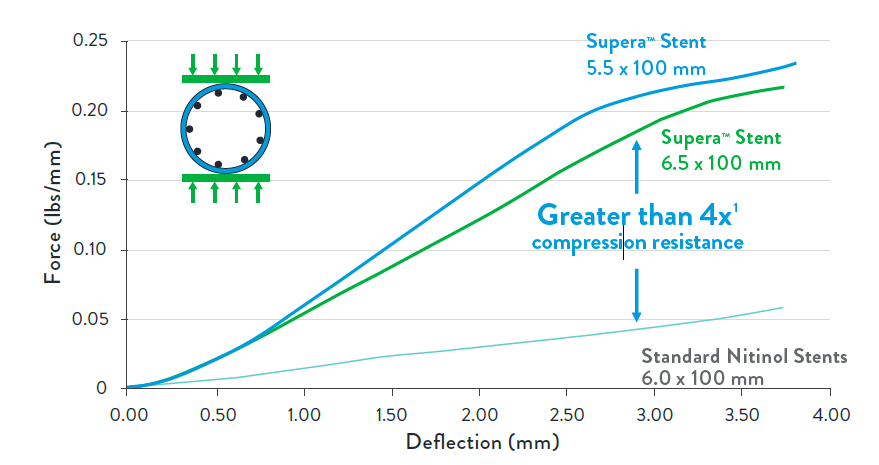The Supera™ Stent’s unique design results in a platform with features unmatched among standard nitinol peripheral stents:
The interwoven nitinol design provides high structural integrity and kink resistance, producing the features that set the Supera™ Stent apart.
The Supera™ Stent exhibits more than 4 times the compression resistance of all other self-expanding nitinol stents.2

Optimizes luminal gain and maintains circular geometry

SUPERA™ STENT21
Same artery shown, with a Supera™ Stent distal to the SNS

SNS21
While laser-cut nitinol stents are designed and required to be oversized for deployment, the Supera™ Stent is unique in that it is sized 1:1 with the vessel diameter. So as seen in the image below, the laser-cut stents inherently exert force on the vessel wall throughout the lifetime of the stent, which in turn can result in endovascular injury over the long term. The lower chronic outward force (COF) with the Supera™ Stent results in fewer vessel injuries.2,4
 | Pushes against the vessel to open, through lifetime of SNS |  |  |
| STENT OVERSIZING | HIGH COF2 | VESSEL INJURY4 | |
| Chronic outward force (COF) is exerted on vessel by self-expanding stents due to inherent oversizing | |||
 | 1:1 sizing allows to scaffold the vessel to maintain open |  |  |
| SIZING 1:1 | LOW COF2 | MINIMAL VESSEL INJURY4 | |
| Supera™ Stent is sized 1:1 with the prepared vessel and therefore has minimal chronic outward force | |||
Other self-expanding nitinol stents are fashioned from a rigid, inflexible tube that is laser-cut. As shown in the photo below, due to design and materials properties, some laser cut stents are less likely to conform to a dynamic vascular environment and can potentially kink and fracture in tortuous vessels (left).


With the Supera™ Stent, however, individual flexible nitinol wires are interwoven for unparalleled flexibility,3 excellent kink resistance, and the ability to mimic the natural movement of the anatomy1,21,22 (right).
Consequently, data on over 2,000 patients published in 17 studies have shown that at 1 year the Supera™ Stent has zero fractures.4-20

MAT-2106533 v2.0
You are about to enter an Abbott country- or region-specific website.
Please be aware that the website you have requested is intended for the residents of a particular country or countries, as noted on that site. As a result, the site may contain information on pharmaceuticals, medical devices and other products or uses of those products that are not approved in other countries or regions
Do you wish to continue and enter this website?
MAT-2305078 v1.0